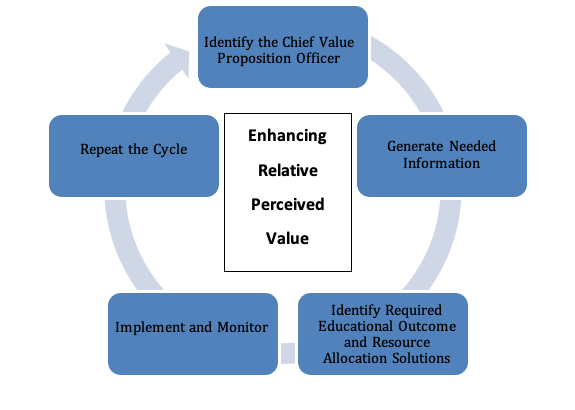By Dr. Harry Bloom
Measuring Success’ research among hundreds of independent schools of all sizes and types across a full spectrum of market situations indicates that a school’s relative perceived value compared to tuition determines its new enrollment. Relative perceived value also drives retention or attrition among current families.

Most Schools Have A Perceived Value Challenge
In most communities and the U.S. overall, ⅓ of private schools are growing enrollment, ⅓ are struggling to stay even and ⅓ are experiencing declining enrollment. Thus, by definition, most schools need to focus on improving their management of relative perceived value.
Who is the “Go to” Person Who Oversees Management of Your School’s Relative Perceived Value?
But a fair question for you is who (other than you, who as Head of School are accountable for everything!) is accountable for actively managing this equation to ensure all the necessary components are being holistically optimized? The answer, for most schools, is, unfortunately, no one. Yes, there are staff in enrollment management who manage the enrollment funnel and input into it and output from it. There are staff in marketing who manage brand research and image and messaging. There are staff in finance who manage budgeting, accounting and financial planning and have input into tuition setting. But generally, no one is looking at the totality of the picture and paying attention to external benchmarking and to how to surpass the competition overall. This is a serious gap.
5 Steps to Manage Relative Perceived Value
- Establish Accountability: Make someone in your organization accountable for diagnosing improvement needs and project managing needed corrective action. I have seen gifted, proactive CFOs effectively tackle this, but the leadership can come from any functional area leader with breadth of perspective and solid leadership skills who is chartered to take on the defacto role of Chief Value Proposition Officer.
- Generate the Needed Information: Conduct the research among prospective and current families to identify your school’s relative perceived strengths and weaknesses on the outcomes that matter most to the customer. Perform comprehensive benchmarking of your school’s key revenue generation, expense management and asset utilization ratios compared to those of respected peer schools to pinpoint better ways to utilize resources and minimize tuition increases.
- Convene the Team and Define the Required Corrective Areas and Actions: Form a working team of key functional leadership under the guidance of the Chief Value Proposition Officer. Allocate the areas of opportunity/weakness that were identified during the Generate the Data phase to relevant, influential school leaders. Work with them to them to define improvement hypotheses and then corrective programs that remedy weaknesses and optimize resource allocations to what matters most.
- Project Manage Corrective Action to Fruition: Define implementation responsibilities, timeframes of required action, anticipated progress milestones. Codify the collective plans into a schoolwide financial roadmap. Meet regularly as a team to measure and review progress and define corrective action as needed. This disciplined process has helped scores of schools make measurable progress that results in enhanced quality and better utilization of tuition and non-tuition dollars that lead to enrollment growth.
- Repeat the process every 3rd year. Improvement cycles generally take time to come to fruition although there will be immediate gains. Expect to repeat the Generate the Needed Information phase every 3rd year and then repeat the cycle. Watch the growth in organizational wisdom, enrollment, and esprit d’corps that flows from the process! Yours is now a learning organization, able to master the strengthening of its relative perceived value and growth.

This systematic approach has been used by numerous schools to materially impact school finances and relative value proposition and can work for your school as well. It all starts with a recognition that deficits in Relative Perceived Value Proposition can be effectively managed but require defined leadership and a data informed, disciplined process to achieve improvement. Your school’s enrollment and financial and marketplace vitality are in the balance, and today is the day to take action.
Measuring Success has over 15 years of experience helping independent schools measure what needs to be measured, identify corrective action, and monitor progress through to success. I would be delighted to assist your school in this regard. Please contact me to discuss how we can support your efforts to increase Relative Perceived Value.
Dr. Harry Bloom, SVP of Client Solutions
Measuring Success
For questions about these takeaways, or to find out more about Measuring Success’ tailored survey offerings, please email Harry.